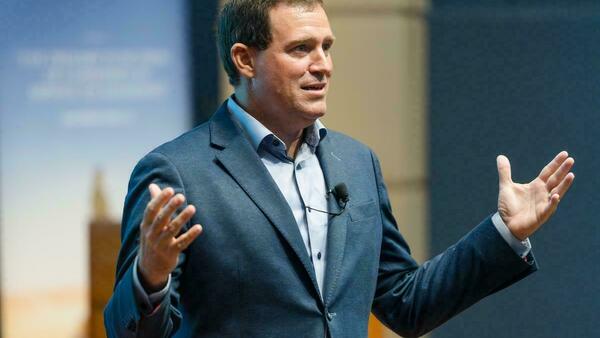Resolutions, diets, the latest exercise routines - we are inundated with “new year, new you” messages each January. This time of year also marks a bit of a reset at work - many of us return to the office after extra time with loved ones over the holidays.
As we consider our priorities and well-being, our work is rightly a key focus. The workplace is where many of us spend most of our time, alongside the people with whom we endeavor to create meaning and impact. The time is right for reevaluation and rejuvenation. And the attention business leaders should pay to their own engagement at work - and that of their employees - is a year-round issue.

Employees across many industries are reporting dissatisfaction - a recent Gallup poll reflects that more than 60% of employees feel detached at work - with many “quiet quitting”. And trends of reported engagement are moving in the wrong direction. A recent survey of thousands of North American knowledge-based sector workers found a significant increase in those describing themselves as “often” or “almost always” feeling burnt out. Other studies find that 70% of workers say they’ve experienced burnout in the last year, and that American workers are now among the most stressed in the world. Globally, under-engaged workers cost nearly $9 trillion in lost productivity. This is bad news for all of us.
The state of the world is a factor. In the context of very real challenges including post-pandemic economic uncertainty, conflict, social unrest and political discord, and concerns about a changing climate, it is no wonder many of us are struggling. It is also about balance. Three out of four US workers also have caregiving roles at home.
But here’s the good news. We know a lot about what works to make navigating these challenges more manageable.
Connections with each other - and with nature
Connectedness to central human goods is critical. Research tells us that our innate connections to other people, and to nature, can be leveraged to help us be happier, more productive people at work. When we seek to motivate ourselves and our organizations to be more inclusive of each other and more environmentally sustainable we, and our organizations, are better off.
What doesn't work is focusing exclusively on the gloom and doom. This does not mean we should ignore the very real challenges right in front of us. But we can move beyond feelings that are overwhelming, immobilizing, and insurmountable. We do this by approaching these challenges together - by recognizing the social and environmental ecosystem of which we, and our organizations, are all a part.
Showing appreciation for our people, which we know enhances engagement and productivity, and pursuing strategies that advance rather than work against human and environmental flourishing, are approaches that work. Intentionally and explicitly addressing engagement is key.
Consider this example. A recent Gallup study showed only 42 percent of employees surveyed feel they are recognized appropriately at work, and 29 percent report that they are never recognized or appreciated at work. A lack of recognition or appreciation has been cited among the most common reasons people leave their jobs. The same study found that when employees feel appreciated, they are 73 percent less likely to get burned out, five times more likely to feel connected to their company's culture, and four times as likely to be engaged at work. This translates to reduced turnover and increased productivity and satisfaction - a win-win for your employees and your business.
We also know that employees increasingly seek employers who value responsible, equitable workplaces and a sustainable natural environment, and who pursue strategies to institutionalize and actionalize those values. Pursuing meaningful commitment to the well-being of our people and the world around us is key to recruiting and retaining today’s top talent.
Employees are at their happiest - and most productive - when they feel engaged, appreciated, and motivated at work. Rejuvenation is an ethical issue - engaged and happy employees allow for human flourishing and organizational excellence.
What can leaders do?
The choices made by our organizational leaders are key. Professor and NDDCEL Faculty Fellow Christopher Adkins describes leaders as designers. They design the conditions - the environments and experiences - where individuals create value for others and for themselves. Insights from Professor Adkins’ Tender - Strong - True approach to leadership will be the focus of an upcoming NDDCEL feature.
Innovative research suggests we can re-energize at work through connecting more meaningfully with each other and with the natural environment. We also know depletion of energy and motivation is associated with increased challenges in navigating ethical dilemmas. Our work is where we spend most of our waking hours and much of our creative attention. Rejuvenation and connection can work for us in so many ways.

Employee burnout - and what it takes to rejuvenate - is a key focus of research by Professor Cindy Muir (Zapata) of the department of management and organization (M&O).
Solutions can start with assessing your employees in a meaningful yet simple way. The Muir Matches Measure, presented in research by lead author Professor Muir (Zapata) and colleagues including Mendoza assistant professor of management and organization O. Dorian Boncoeur, can be presented by leaders or HR teams, and employees can point out which match best represents how they feel at work. It relies on a visual which is translatable across countries and cultures, so even international companies can deploy it. The researchers note,
Visual scales provide a way for people to more easily articulate their feelings. The measure is similar to the pain scale that doctors use. Traditional engagement and burnout assessments often take the form of long surveys and personal inventories - useful, but may be seen as just one more task for completion. Visual scales make it easier for employees to express their feelings, and allow for regular, quick check-ins. The research confirms the measure is just as effective as existing tools, while it cuts down on the investment required to administer them. The measure eliminates one of the reasons organizations fail to assess their employees regularly: time.
We spoke with Professor Muir (Zapata) for more insights:
What does burnout at work look like today?
Exhaustion (i.e., depletion or fatigue) has long been thought of as the “the central strain dimension of job burnout” (Bakker et al., 2014). Of course, burnout is more than exhaustion. It is sustained exhaustion that is often coupled with cynicism (i.e., disengagement or depersonalization; an indifference to vital aspects of one’s work), and low professional efficacy (a reduced sense of personal accomplishment or perceived ability to succeed at work (Schaufeli et al., 2009)).
What burnout looks like has not changed.... What has changed, however, is its pervasiveness across occupations.
Why is understanding employee burnout critical for ethical leaders?
Burnout is associated with a whole host of negative outcomes, including decreased job satisfaction, increased turnover intentions, and overall decreased organizational commitment.
What are the most important ways that companies can address employee stress at work?
Something we don’t talk enough about in my view is modeling good behavior for employees. It is hard for employees to engage in the kinds of behaviors we know are restorative, such as taking time off, if leadership is not doing so. That said, a simple, intuitive way scholars talk about burnout is by emphasizing the importance of demands not exceeding one’s resources.
What are some of the signs and symptoms of burnout? What tips do you offer for people experiencing these symptoms?
When employees are feeling consistently burned out, some of the signs will be the consequences of burnout (outlined above). But you want to avoid burning out, so checking in with yourself periodically can help you realize if the demands on your time are too taxing, or whether you have sufficient resources.
What would you most like business leaders to know about employee burnout? What are the most important things managers can do to enhance engagement?
I'd like business leaders to know that sometimes employees need to be saved from themselves. Many of your best employees want to do and be all things to everyone, but that is simply not possible. And sometimes, we have to ensure that employees are not overburdened at work before it becomes a big problem.
Professor Muir (Zapata) offers suggestions for dealing with burnout that leaders can model, and encourages leaders to provide channels for employee access through workshops and other resources.
- One of the many struggles people have is taking on too much in either the work or family domain, and that leads to conflict. Some pretty amazing research describes how to rely on decision-making rules to help you decide quickly whether you can take on that new work project or new activity for your child. It's a struggle when you genuinely want to help but are stretched too thin and requests keep coming in. Tips from running small businesses can help our families run more smoothly.
- Meditation and mindfulness are shown to enhance our resilience, productivity, communication, and more.
In addition to business best practices including accessible mental health resources and other institutional commitments to employee well-being, an everyday commitment to employee engagement helps all of us.
As we think about our own engagement at work, we should keep in mind that rest and rejuvenation are not rewards for hard work. They are fundamental to well-being and a necessary part of a productive life.
Put it in Practice
- Consider these resources as conversation starters or reflection prompts at work.
- Start by assessing where your employees are with burnout.
- Leverage the benefits of connectedness by creating time and space for these efforts. Consider doing so during regular work hours - asking employees to engage in social activities after hours can increase stress - particularly for those employees managing family and other commitments.
- Organize opportunities to engage with others and with nature in meaningful ways - volunteer days, gift passes to local parks, and other creative approaches.
- Be explicit about connecting individual effort to impact and meaning. Show employees how their contributions fit within the larger mission. Engage in practices that reflect commitment to inclusive workplaces and a healthy, sustainable natural environment.
- Model rejuvenation.
- Ask for feedback - and listen and adjust.
Start the Conversation in YOUR Workplace: Download one-page resource here
Further Reading
"This visual tool can assess burnout on your team" (Quartz)
"The Muir Matches Measure" (Mendoza Business Magazine)
World Economic Forum - "This picture can help assess burnout at work" (video)
More on Burnout and Rejuvenation at Work
"Will meaningful work make your employees moral?" (NDDCEL)
"Is burnout finally 'high-profile' enough for leaders to act?" (BBC, 2023)
"Manage work stress like a boss" (Calm.com)
"Seven strategies to avoid burnout" (Deloitte, 2023)
"New York Times Energy Challenge 2024"
"Why rest takes hard work" (Time.com, 2024)
"Is it possible to build 'burnout immunity'?" (Fortune, 2024)
"How a walk in nature restores attention" (University of Utah, 2024)
"Our Bossses Tell Us to Unplug from Work. We Don't Believe They Mean It" (Wall Street Journal, 2024, featuring research by Mendoza assistant professor Casher Belinda)
Faculty Publications
Matches Measure: A Visual Scale of Burnout (Muir (Zapata), C. P., Calderwood, C., & Boncoeur, O. D., 2023, Journal of Applied Psychology)







